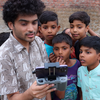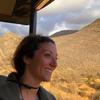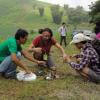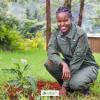With new technologies revolutionizing data collection, wildlife researchers are becoming increasingly able to collect data at much higher volumes than ever before. Now we are facing the challenges of putting this information to use, bringing the science of big data into the conservation arena. With the help of machine learning tools, this area holds immense potential for conservation practices. The applications range from online trafficking alerts to species-specific early warning systems to efficient movement and biodiversity monitoring and beyond.
However, the process of building effective machine learning tools depends upon large amounts of standardized training data, and conservationists currently lack an established system for standardization. How to best develop such a system and incentivize data sharing are questions at the forefront of this work. There are currently multiple AI-based conservation initiatives, including Wildlife Insights and WildBook, that are pioneering applications on this front.
This group is the perfect place to ask all your AI-related questions, no matter your skill level or previous familiarity! You'll find resources, meet other members with similar questions and experts who can answer them, and engage in exciting collaborative opportunities together.
Just getting started with AI in conservation? Check out our introduction tutorial, How Do I Train My First Machine Learning Model? with Daniel Situnayake, and our Virtual Meetup on Big Data. If you're coming from the more technical side of AI/ML, Sara Beery runs an AI for Conservation slack channel that might be of interest. Message her for an invite.
Header Image: Dr Claire Burke / @CBurkeSci

Explore the Basics: AI
Understanding the possibilities for incorporating new technology into your work can feel overwhelming. With so many tools available, so many resources to keep up with, and so many innovative projects happening around the world and in our community, it's easy to lose sight of how and why these new technologies matter, and how they can be practically applied to your projects.
Machine learning has huge potential in conservation tech, and its applications are growing every day! But the tradeoff of that potential is a big learning curve - or so it seems to those starting out with this powerful tool!
To help you explore the potential of AI (and prepare for some of our upcoming AI-themed events!), we've compiled simple, key resources, conversations, and videos to highlight the possibilities:
Three Resources for Beginners:
- Everything I know about Machine Learning and Camera Traps, Dan Morris | Resource library, camera traps, machine learning
- Using Computer Vision to Protect Endangered Species, Kasim Rafiq | Machine learning, data analysis, big cats
- Resource: WildID | WildID
Three Forum Threads for Beginners:
- I made an open-source tool to help you sort camera trap images | Petar Gyurov, Camera Traps
- Batch / Automated Cloud Processing | Chris Nicolas, Acoustic Monitoring
- Looking for help with camera trapping for Jaguars: Software for species ID and database building | Carmina Gutierrez, AI for Conservation
Three Tutorials for Beginners:
- How do I get started using machine learning for my camera traps? | Sara Beery, Tech Tutors
- How do I train my first machine learning model? | Daniel Situnayake, Tech Tutors
- Big Data in Conservation | Dave Thau, Dan Morris, Sarah Davidson, Virtual Meetups
Want to know more about AI, or have your specific machine learning questions answered by experts in the WILDLABS community? Make sure you join the conversation in our AI for Conservation group!
No showcases have been added to this group yet.
Forester/ Ecologist with a Master’s Degree in the department of Range science - Wildlife and Fresh water fisheries.
- 0 Resources
- 0 Discussions
- 11 Groups
- @Pooja_Lama
- | She/Her
I am an early career researcher who is interested in contributing to wildlife conservation.
- 0 Resources
- 0 Discussions
- 9 Groups
- @sarthakvarora
- | he/any
Sustainability and Computer Vision
- 0 Resources
- 0 Discussions
- 7 Groups
- @MandyEyrich
- | She/Her
University of Florida (UF)
Bridging industries with 15+ years of cross-sector expertise specializing in user-centric technology and product strategy, UX research, UX/UI design, process optimization, and end-to-end agile product development moving from ideation to iteration.
- 0 Resources
- 0 Discussions
- 26 Groups
- @ece_zen
- | she/her
Computer scientist
- 0 Resources
- 0 Discussions
- 5 Groups
Full stack engineer focused on AI/ML. I have bench experience in developmental biology and am especially interested in applying machine learning to real-world problems in ecology and conservation
- 0 Resources
- 0 Discussions
- 1 Groups
- @santhosh
- | he/him/his
Leads Technology for Conservation programme at The Habitats Trust
- 0 Resources
- 3 Discussions
- 10 Groups
- @jasminedaly
- | she/her/hers
Principal Consultant & Founder of Daly Analytics which helps nonprofits and purpose-driven teams make sense of their data.

- 0 Resources
- 1 Discussions
- 6 Groups
- @lhughey
- | she/her
Smithsonian Conservation Biology Institute
I am an ecologist and program manager with experience leading collaborative research projects in international settings. I specialize in the application of animal tracking data to conserve migratory species on a changing planet.



- 6 Resources
- 10 Discussions
- 3 Groups
- @KellyFaller
- | she/her/hers
Rutgers University
Lead Estuary Science Coordinator at the Partnership for the Delaware Estuary and Masters Student at Rutgers University in the Department of Ecology and Evolution. Using bioacoustics in tidal marsh ecosystems for restoration and conservation.

- 0 Resources
- 4 Discussions
- 14 Groups
Sustainability Manager for CERES Tag LTD. An animal health company; animal monitoring, conservation, & anti-poaching/ rural crime. Wildlife, livestock, equine & companion. #CeresTrace #CeresWild #CeresRanch





- 2 Resources
- 20 Discussions
- 23 Groups
- @SimonsVictor
- | Marsha
I'm passionate about wildlife and animal management on development of conservation strategies for a long time monitoring
- 0 Resources
- 0 Discussions
- 8 Groups
Driving off-highway vehicles (OHVs), which contributes to habitat degradation and fragmentation, is a common recreational activity in the United States and other parts of the world, particularly in desert environments...
8 April 2025
Conservation International is proud to announce the launch of the Nature Tech for Biodiversity Sector Map, developed in partnership with the Nature Tech Collective!
1 April 2025
$3 millions of funding for NGO in Brazil using AI for conservation / $ 3 milhões em financiamento para ONGs no Brasil que usam IA para conservação!
1 April 2025
Funding
I have been a bit distracted the past months by my move from Costa Rica to Spain ( all went well, thank you, I just miss the rain forest and the Ticos ) and have to catch up on funding calls. Because I still have little...
28 March 2025
Funding
The AI Weather Quest, organised by the European Centre for Medium-Range Weather Forecasts (ECMWF), is an ambitious international competition designed to harness artificial intelligence (AI) and machine learning (ML) in...
25 March 2025
InsectSet459 - the first large-scale open dataset of insect sounds, featuring 26,399 audio clips from 459 species of Orthoptera and Cicadidae.
24 March 2025
Naturalis is looking for a postdoc in AI for Ultrasonic Bioacoustic Monitoring
24 March 2025
Funding
The Compute for Climate Fellowship is a global R&D funding program that empowers climate tech startups to leverage advanced cloud computing and AI in the fight against climate change.
22 March 2025
Absolutely fascinating uses of AI for equitable conservation! Hope it inspires you!
21 March 2025
Naturalis is looking for a postdoc in AI for Ultrasonic Bioacoustic Monitoring!
21 March 2025
This thesis concludes that artificial intelligence offers valuable opportunities for mitigating the impacts of climate change on wildlife with careful consideration of its limitations and ethical implications.
10 March 2025
WWF's Arctic Community Wildlife Grants program supports conservation, stewardship, and research initiatives that focus on coastal Arctic ecology, community sustainability, and priority Arctic wildlife, including polar...
7 March 2025
August 2025
event
September 2025
event
event
event
event
October 2025
event
event
event
December 2025
event
March 2026
November 2024
October 2024
17 Products
Recently updated products
| Description | Activity | Replies | Groups | Updated |
|---|---|---|---|---|
| Bluesky have a commercial tree crown dataset available covering most of Great Britain (England, Wales and parts of Scotland). There is a canopy layer with approximate outlines of... |
|
AI for Conservation, Drones | 2 years 6 months ago | |
| Rainforest Connection's (RFCx) Guardian devices may be of interest. They are solar-powered and have connectivity options for Wifi, GSM and satellite transfer. They've previously... |
|
Acoustics, AI for Conservation, Connectivity, Data management and processing tools, Protected Area Management Tools, Sensors | 2 years 6 months ago | |
| My original background is in ecology and conservation, and am now in the elected leadership of the Gathering for Open Science Hardware which convenes researchers developing open... |
|
AI for Conservation, Animal Movement, Camera Traps, Conservation Tech Training and Education, Data management and processing tools, Drones, Emerging Tech, Sensors | 2 years 6 months ago | |
| Hi Sophie, Can you please help me or get in touch in developing a system where we are able to detect an Elephant? Would like to discuss more about it. Kindly treat this as urgent!! |
+8
|
AI for Conservation | 2 years 7 months ago | |
| Hello All - @sarabeery et Al have just put a pre-print out on their educational insights into teaching Computer Vision to ecologists. I... |
|
Acoustics, AI for Conservation, Conservation Tech Training and Education, Early Career, Emerging Tech | 2 years 7 months ago | |
| The Conservation Technology Lab at San Diego Zoo seeks undergrads for summer projects in computer vision, machine learning, bioacoustics,... |
|
Acoustics, AI for Conservation, Conservation Tech Training and Education | 2 years 7 months ago | |
| I just came across this interesting paper in which seismic monotoring of animals like elephants was mentioned. This is the study refered to:Cheers,Lars |
|
AI for Conservation, Camera Traps, Emerging Tech, Ethics of Conservation Tech, Human-Wildlife Coexistence, Geospatial, Sensors | 2 years 8 months ago | |
| Quick reminder that the deadline for applications is just shy of a week away. This workshop is particularly geared to teach ecologists computer vision tools to apply to their... |
|
Conservation Tech Training and Education, AI for Conservation | 2 years 8 months ago | |
| Hahaha, now I see why you were asking ... |
|
AI for Conservation | 2 years 8 months ago | |
| Hi all, one of the 8 MozFest 2023 spaces is 'Tech & Biodiversity', and the organisers seek input for an event on the intersection of... |
|
AI for Conservation, Ethics of Conservation Tech, Open Source Solutions | 2 years 8 months ago | |
| Out of curiosity, what are the similarities/differences between your platform and other image classification ones such as Wildlife Insights, WildID, ZambaCloud? I don't mean that... |
|
AI for Conservation, Emerging Tech | 2 years 9 months ago | |
| Thanks so much!! |
|
Acoustics, AI for Conservation, Animal Movement, Camera Traps, Community Base, Data management and processing tools, Drones, eDNA & Genomics, Emerging Tech, Open Source Solutions, Geospatial, Software Development | 2 years 10 months ago |
REDAA is hiring a consultant to explore AI - DEADLINE EXTENDED
11 July 2024 12:33pm
ForestSAT
5 July 2024 7:04pm
Question About Interpolation
18 June 2024 10:52pm
28 June 2024 6:35pm
The use of synthetic training data such as interpolated sequence values is common, but fraught with the issue of your synthetic signal generating features that are not true to real life.
Instead, you might think about about appending the values of two long-period sin waves per input element to the sequence going in to your first linear / fully-connected layer. The simplest thing that could possibly work would be to interpret minute of the day and day of the month as the values of your sin wave! (Or perhaps minute/hour if all training sequences are quite short.) Since you’re doing sequence prediction, you would add the appropriate values for each image(?) in the sequence being evaluated.
With that additional signal going in to the model in the early layers, the NN should have a good chance of learning that the differences in the modulating signal corresponds to distance in time.
This technigue was popularized by early Large Language Models to encode the distance between words. There’s been refinement (search “Rotary Encoding” for instance) but the basic idea of sin waves generalizes well.
Workflow for automated precise seeding with drones and artificial intelligence
20 June 2024 12:22pm
FOSS Geospatial Tools
Deep learning & bioacoustics postdoc in Cape Town, South Africa
14 June 2024 1:52pm
Conservation Technology for Human-Wildlife Conflict in Non-Protected Areas: Advice on Generating Evidence
22 January 2024 11:36pm
4 February 2024 8:16am
Hi Amit,
The most important thing is that the livestock owners contact you as soon as possible after finding the carcass. We commonly do two things if they contact us on the same day or just after the livestock was killed:
- Use CyberTracker (or similar software) on an Android smart phone to record all tracks, bite marks, feeding pattern and any other relevant signs of the reason for the loss with pictures and GPS coordinates. [BTW, Compensation is a big issue -- What do you do if the livestock was stolen? What do you do if a domestic animal killed the livestock? What if it died from disease or natural causes and was scavenged upon by carnivores afterwards?]
- In the case of most cats, they would hide the prey (or just mark it by covering it with grass or branches and urinating in the area). In this case you can put up a camera trap on the carcass to capture the animal when it returns to its kill (Reconyx is good if you can afford it - we use mostly Cuddeback with white flash). This will normally only work if the carcass is fresh (so other predators would not be able to smell it and not know where it is yet), so the camera only has to be up for 3-5 days max.
This is not really high-tech, but can be very useful to not only establish which predator was responsible (or if a predator was responsible), but also to record all the evidence for that.
13 June 2024 8:58pm
Hey Amit,
This is a great question; from our work, we've seen people do a couple of things. We've even seen people using Ring doorbell footage in urban areas as evidence.
The best thing we've seen is matching the community needs with existing infrastructure:
- Are there existing cameras you can leverage, like the doorbell cameras?
- Can public participation monitoring service this, i.e. public submitted photos and videos?
It also totally depends on the wildlife species you're working with, the interaction, damages, etc. If you've found any good solutions, let me know. I'd love to share that information with our clients here who have constant bear problems.
14 June 2024 9:09am
In that case, you might want to keep an eye on the project from @Lars_Holst_Hansen
I have been working hard on this camera based polar bear alarm with Kim Hendrikse and other collaborators including Zoologisk Have in Copenhagen - where the system is now beeing tested. | Lars Holst Hansen | 17 comments
I have been working hard on this camera based polar bear alarm with Kim Hendrikse and other collaborators including Zoologisk Have in Copenhagen - where the system is now beeing tested. I hope to field test it at Zackenberg Research Station next year. | 17 comments on LinkedIn
Bezos Earth Fund, AI for Climate and Nature Grand Challenge call for $50K-2M projects
12 June 2024 2:58pm
Postdoctoral Research Associate: Bioacoustics & population modeling
11 June 2024 9:35pm
Fully funded PhD in AI biodiversity monitoring
11 June 2024 1:07pm
AI Identification Models on Thermal Data
6 June 2024 8:30pm
7 June 2024 4:06am
Wow! This dataset seems great and definitely worth trying out. Do you perhaps have a dataset for deer, elk, and those animals of the sort?
I live in the mountainous region so deer are very common and easily hit.
Thank you again
7 June 2024 5:43pm
Sorry, the only other dataset of thermal camera trap images that I'm aware of is mostly elephants, although it does have some goats:
https://github.com/arribada/human-wildlife-conflict?tab=readme-ov-file#elephant-dataset
7 June 2024 7:28pm
No worries! I'll be trying the other one to see how it works. Thank you for your help!
VIHAR-2024 deadline extension, June 30th (Interspeech satellite event)
5 June 2024 10:30am
5 June 2024 3:05pm
Thanks for sharing this @nkundiushuti ! I think this post would be better suited as an event, that way it will show up on the WILDLABS event calendar page. Let me know if you have any questions on how to make an event post! You just click the +Post button in the top right corner, then click "event."
7 June 2024 8:29am
hi Alex!! I already posted the event, I just wanted to posted an update: the deadline was extended.
7 June 2024 1:45pm
Fantastic!!
€4,000 travel grants for insect monitoring an AI
6 June 2024 4:49pm
New WILDLABS Funding & Finance group
5 June 2024 3:24pm
5 June 2024 4:14pm
6 June 2024 1:38am
6 June 2024 4:16am
Apply! 2024 Conservation Tech Award
3 June 2024 3:51pm
Recruiting for a paid study on Explainable AI & bird identification
1 June 2024 8:34pm
Announcing: BeetlePalooza 2024
31 May 2024 9:00pm
Bioacoustics and AI 101
29 May 2024 2:21pm
9th Workshop On Detection and Classification of Acoustic Scenes and Events
28 May 2024 8:57pm
32nd European Signal Processing Conference
28 May 2024 8:44pm
5th World Ecoacoustics Congress
28 May 2024 8:07pm
Computational Entomology Webinar III: Processing liquid samples
22 May 2024 12:40am
DeepDive: estimating global biodiversity patterns through time using deep learning
20 May 2024 4:51pm
4th International Workshop onCamera Traps, AI, and Ecology
9 May 2024 1:00pm
Harnessing large language models for coding, teaching and inclusion to empower research in ecology and evolution
9 May 2024 12:51pm
Voices of Sustainability: Perspectives from - Africa Wholesome Sustainability Explained: What is E-PIE
7 May 2024 3:06am
1 July 2024 5:48pm
1 July 2024 6:02pm
3 July 2024 3:30pm
AI & Gamified Citizen Science
3 May 2024 7:24am
3 May 2024 5:09pm
Check out FathomVerse, a new game by MBARI folks for involving citizen scientists in improving algorithms to ID deep sea critters!
FathomVerse | mobile game
FathomVerse is a mobile game designed to inspire a new wave of ocean explorers and improve AI for ocean life.
3 May 2024 8:28pm
This is so cool! I am 1000% going to see if they want to come talk about it at Variety Hou!
Travel grants for insect monitoring an AI
3 May 2024 5:20pm







































































3 September 2024 6:02pm